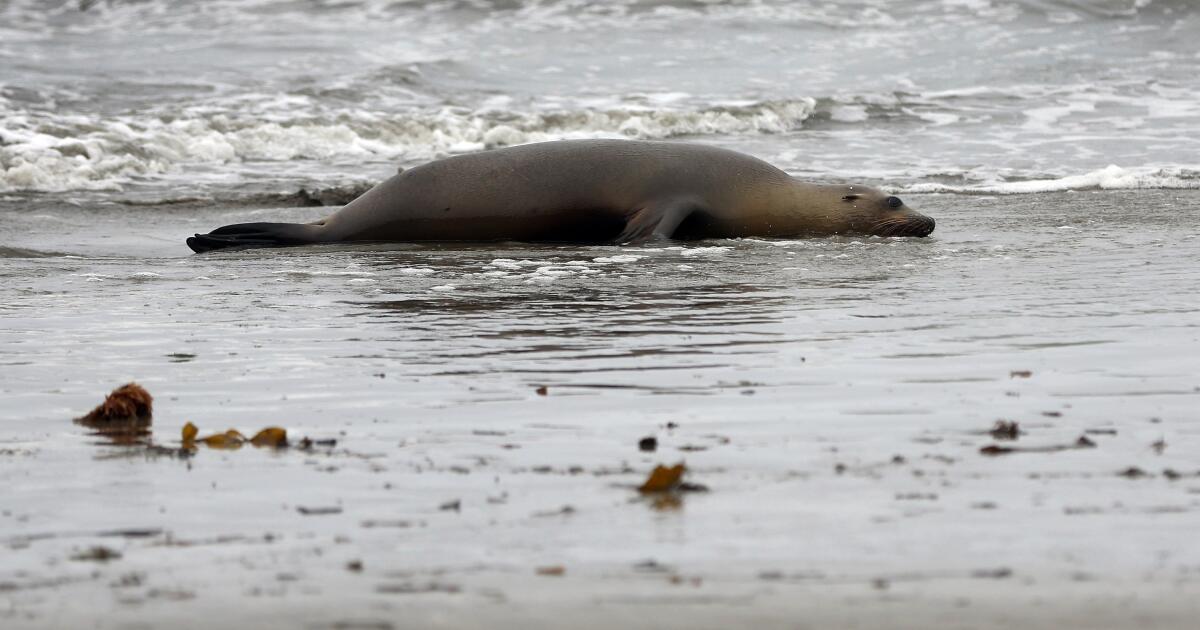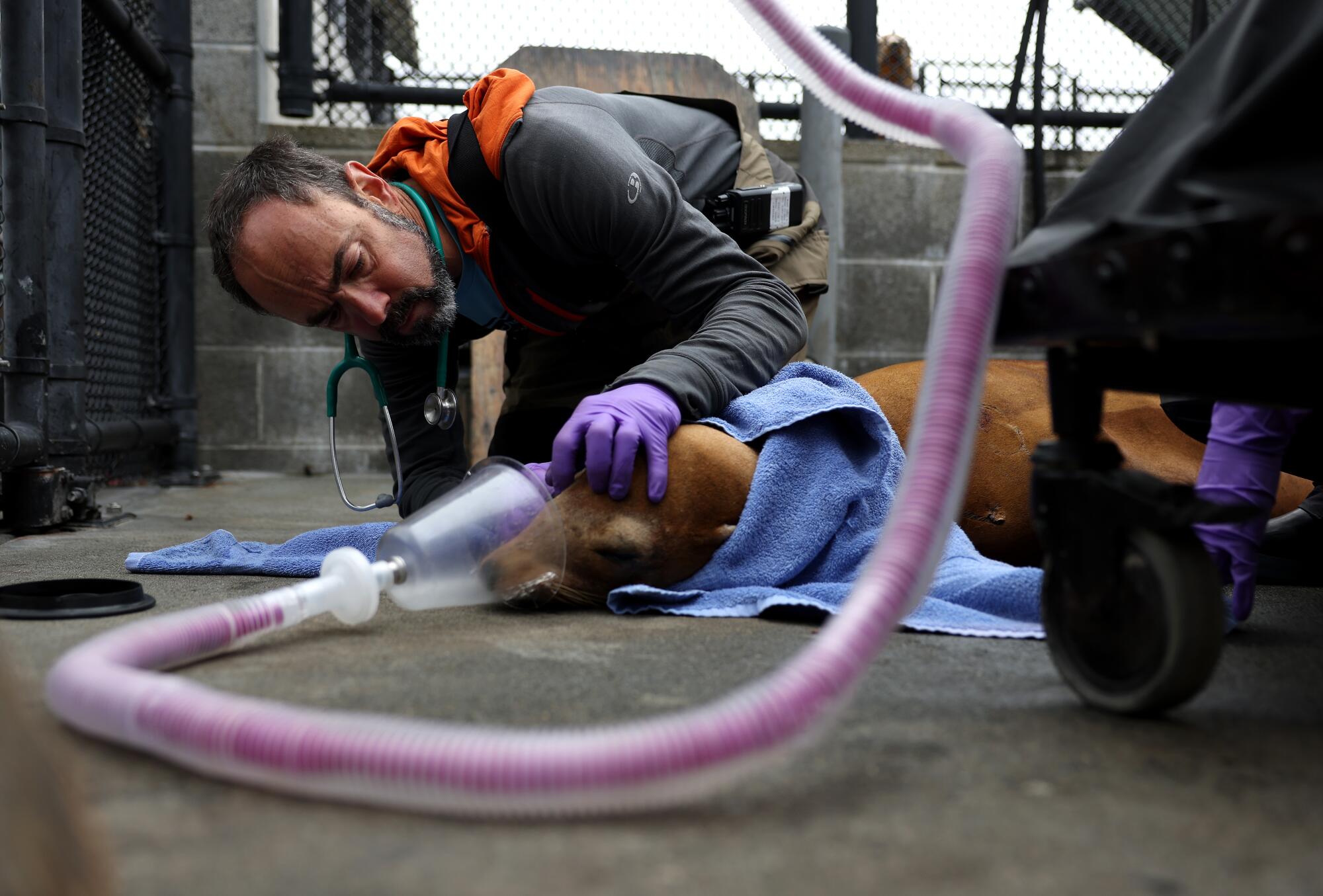Science
Outbreak of neurotoxin killing unprecedented number of sea lions along California coast

By the time the rescue squad got to her, a small crowd had formed around the agitated California sea lion. As the team crept toward her — carrying large wooden shields and a giant net — the animal’s head weaved, craned and rocked back and forth in frenzied rhythms.
Lucille — as she was later named by the Marine Mammal Center’s Morro Bay field office — had barely registered her captors’ approach as the team of five animal rescue volunteers pounced on her. A small struggle ensued as the creature’s body went rigid with seizures, but the team managed eventually to push her into an XXL portable dog crate.
“It’s really hard when they’re not acting like sea lions,” said Jake Roth, a 22-year-old volunteer who helped with the rescue.
It was the first of dozens of frantic rescue phone calls made by horrified beachgoers that day, as an acute domoic acid outbreak continued to wreak havoc along the San Luis Obispo and Santa Barbara coasts this summer.
“The levels we’re finding inside these animals is off the charts,” said Giancarlo Rulli, a spokesman for the Sausalito-based Marine Mammal Center. “It’s all hands on deck.”
Domoic acid is a neurotoxin released by Pseudo-nitzschia, a common phytoplankton species found in coastal waters. Sea lions — and other marine mammals — become poisoned when they eat large amounts of fish or invertebrates that have been chowing on the contaminated diatoms.
Symptoms include lethargy, vomiting, unusual behavior, seizures, loss of pregnancy and death.
Marine Mammal Center volunteer Cris Lewis guides a sick sea lion into a crate during a rescue at Cayucos State Beach.
(Justin Sullivan/Getty Images)
Domoic acid, which is an amino acid, is not always produced by the phytoplankton. It is only manufactured under certain conditions — ones which scientists are still trying to determine. But upwelling of seawater seems to be a common factor — and strong upwelling of cold, nutrient-rich water is currently hugging the Central California coastline.
The outbreak has been at crisis levels since late July.
“One of the things that has come out again and again in a lot of our studies… is that, yes, when you get upwelling — which is typified by colder water temperatures and lots of nutrients — you will stimulate a bloom of diatoms,” said Clarissa Anderson, director of Southern California Coastal Ocean Observing System and the Cooperative Institute for Marine, Earth, and Atmospheric Systems, which are operated out of UC San Diego’s Scripps Institution of Oceanography.
“But then the bigger question — the one we’ve not been able to totally wrap our heads around — is, when does it produce the toxin? What is the mixture of conditions that requires that? Because this organism is around all the time,” she said.
Domoic acid outbreaks are not new. They have been happening for decades, if not millennia. And although it wasn’t identified in California waters until 1991, it is believed to have been behind outbreaks before that — including the 1961 “invasion” of chaotic sea birds in Capitola that partly inspired Alfred Hitchcock’s 1963 film, “The Birds.”
What has changed, said Anderson, are the frequency, timing and location of the events.
“We know that upwelling season in California has always been a great time to expect a Pseudo-nitzschia bloom and potentially a domoic acid event, and that can start as early as March,” she said. As a result, scientists had associated springtime with domoic acid outbreaks.
“But now we’re starting to see something different: These past three summers there have been these intense, long, lasting blooms,” she said.
And while Monterey and Humboldt Bay had been considered the classical hot spots, it’s Southern California that has been clobbered since 2022.
She said climate change is likely playing a role in these changes — but not necessarily because of warm water temperatures.

Marine Mammal Center veterinarian Greg Frankfurter inspects a newly admitted California sea lion that was rescued from a beach showing signs of domoic acid poisoning in Sausalito.
(Justin Sullivan/Getty Images)
“One of the things we have seen in our years and years and years of data is that it’s the mixture of nutrients that come with upwelling that is potentially responsible for turning the toxin on or off,” she said. “And that mixture of nutrients may be impacted by global climate change, because climate change is changing ocean circulation physics at the basin scale — like the Pacific Ocean scale — and that can have ramification on what kinds of water — the flavor of water — that is upwelling onto the coast in California.”
Raphe Kudela, a professor of ocean science at UC Santa Cruz, said there might also be a connection to heat and runoff from inland rivers.
He said in the last few years, really wet winters have contributed to an increase in river runoff — and a resulting dump of nutrients into California’s coastal waters.
“So you get a pulse of upwelling, which brought some cool water with even more nutrients to the surface, and then everything warmed up. That’s just absolutely perfect conditions for a bloom like this,” he said.
It’s also a perfect recipe for creatures like sardines and anchovies, who feast on the diatoms, algae and phytoplankton in these cool, nutrient-rich waters. And those fish bring in predators, such as sea lions, dolphins, fur seals, birds and other fish that then proceed to feast on these “toxic bullets.”
Anderson said people will occasionally ask her if they, too, could get sick from eating anchovies.
“I’m like, are you planning on eating as many anchovy as a sea lion?” she said, noting that sea lions eat roughly 5% to 8% of their body weight per day. For a 150-pound person, that would be 7.5 to 12 pounds of anchovy.
And that’s part of the tragedy of this latest outbreak.
Barbie Halaska, a necropsy specialist with the Marine Mammal Center, showed visitors the milk-rich tissue enveloping the single six-inch incisions she had made in the chests of six of the dead sea lions that had died at the Morro Bay center.
All six were adult, lactating females, she said, with thick layers of fat.
“You can see how big she is. She’s gorgeous,” said Halaska, pointing at the dead but otherwise healthy-looking animal. “They’ve got a great food supply. It just happens to be tainted. When they’re lactating, and they find a good food stock, they just go and go and go. Unfortunately, that means the neurotoxin just bioaccumulates.”
She said female sea lions tend to give birth around June 15 — “we call it sea lion birthday” — which means these females most likely had a young, dependent pup with them before they were stranded. Sea lion pups are dependent on their mothers until they are about 9 months old.
Research shows that pups growing inside contaminated pregnant females suffer brain damage. Milk from contaminated females also carries the toxin, suggesting it could be transmitted to pups.
By early afternoon, Lucille and three other sea lions were being treated for domoic acid poisoning.
Lucille was passed out, snoring on the cement floor of the pen. Soon after she arrived, a center staff member had delivered a shot full of phenobarbital and midazolam into her back haunch, to control the seizures. Staff then hooked her up to an IV bag of fluid to help flush the toxin out of her body.
But one of the three newer arrivals, a large, adult female named Yippee, arrived with a broken and dislocated jaw. Staff concluded she’d die if she was returned to the wild. They made the hard decision to medically euthanize her.
She struggled to flee from the small team that came in to deliver the shot, but was finally backed into a corner and succumbed. Her breathing slowed and within a few minutes, she was still.
Rulli said such episodes are always painful, and the center works hard to support staff who respond to these events. Repeated encounters with suffering animals can take a toll.
Roughly 30% of the animals that have come to the center in this latest outbreak — which began at the end of July — have died, said Aliah Meza, operation manager of the Morro Bay field office.
Farther south, where staff from the Channel Islands Marine Wildlife Institute are responding to animals along the Santa Barbara and Ventura coasts, the number exceeds 50%, said Sam Dover, founder and chief veterinarian of Channel Islands Marine and Wildlife Institute.
To keep these facilities running and these teams operating, both institutions rely on donations and some level of state and federal funding.
State funding was nearly pulled last year when the governor’s office struck $2 million in funding from the state budget. For smaller operations, such as Dover’s, that would have been a 50% hit on its operating budget. The groups were able to convince lawmakers to replace the funding.
“I don’t envy the sharpened pencil and eraser work that they were doing,” said Jeffrey Boehm, the marine center’s chief external relations officer, who said he and others went to Sacramento to make the case that their work is in the public interest. “Having an entity that is prepared, skilled and professional to respond to wildlife that might be having a seizure on a public beach, that’s in the public interest. As is the science we advance through doing this work… Because at the end of the day, it’s all just one system.”
Lucille, who recovered from her seizures, was transported to the center’s Sausalito hospital via air-conditioned truck the following day. She died in transport.
Veggie, another sea lion who was rescued the same day, did make it to Sausalito however. She is now undergoing a seven-day protocol at the hospital, where roughly 50 other sea lions are being treated.
Rulli said that two sea lions were recently released back into the wild at Point Reyes National Seashore, where there is no sign of an outbreak and where humpback whales are currently feeding — an indication that there’s plenty of food available.
“Let’s just hope they stay up here,” he said.

Science
Trump administration declares ‘war on sugar’ in overhaul of food guidelines

The Trump administration announced a major overhaul of American nutrition guidelines Wednesday, replacing the old, carbohydrate-heavy food pyramid with one that prioritizes protein, healthy fats and whole grains.
“Our government declares war on added sugar,” Health and Human Services Secretary Robert F. Kennedy Jr. said in a White House press conference announcing the changes. “We are ending the war on saturated fats.”
“If a foreign adversary sought to destroy the health of our children, to cripple our economy, to weaken our national security, there would be no better strategy than to addict us to ultra-processed foods,” Kennedy said.
Improving U.S. eating habits and the availability of nutritious foods is an issue with broad bipartisan support, and has been a long-standing goal of Kennedy’s Make America Healthy Again movement.
During the press conference, he acknowledged both the American Medical Association and the American Assn. of Pediatrics for partnering on the new guidelines — two organizations that earlier this week condemned the administration’s decision to slash the number of diseases that U.S. children are vaccinated against.
“The American Medical Association applauds the administration’s new Dietary Guidelines for spotlighting the highly processed foods, sugar-sweetened beverages, and excess sodium that fuel heart disease, diabetes, obesity, and other chronic illnesses,” AMA president Bobby Mukkamala said in a statement.
Science
Contributor: With high deductibles, even the insured are functionally uninsured

I recently saw a patient complaining of shortness of breath and a persistent cough. Worried he was developing pneumonia, I ordered a chest X-ray — a standard diagnostic tool. He refused. He hadn’t met his $3,000 deductible yet, and so his insurance would have required him to pay much or all of the cost for that scan. He assured me he would call if he got worse.
For him, the X-ray wasn’t a medical necessity, but it would have been a financial shock he couldn’t absorb. He chose to gamble on a cough, and five days later, he lost — ending up in the ICU with bilateral pneumonia. He survived, but the cost of his “savings” was a nearly fatal hospital stay and a bill that will quite likely bankrupt him. He is lucky he won’t be one of the 55,000 Americans to die from pneumonia each year.
As a physician associate in primary care, I serve as a frontline witness to this failure of the American approach to insurance. Medical professionals are taught that the barrier to health is biology: bacteria, viruses, genetics. But increasingly, the barrier is a policy framework that pressures insured Americans to gamble with their lives. High-deductible health plans seem affordable because their monthly premiums are lower than other plans’, but they create perverse incentives by discouraging patients from seeking and accepting diagnostics and treatments — sometimes turning minor, treatable issues into expensive, life-threatening emergencies. My patient’s gamble with his lungs is a microcosm of the much larger gamble we are taking with the American public.
The economic theory underpinning these high deductibles is known as “skin in the game.” The idea is that if patients are responsible for the first few thousand dollars of their care, they will become savvy consumers, shopping around for the best value and driving down healthcare costs.
But this logic collapses in the exam room. Healthcare is not a consumer good like a television or a used car. My patient was not in a position to “shop around” for a cheaper X-ray, nor was he qualified to determine if his cough was benign or deadly. The “skin in the game” theory assumes a level of medical literacy and market transparency that simply doesn’t exist in a moment of crisis. You can compare the specs of two SUVs; you cannot “shop around” for a life-saving diagnostic while gasping for air.
A 2025 poll from the Kaiser Family Foundation points to this reality, finding that up to 38% of insured American adults say they skipped or postponed necessary healthcare or medications in the past 12 months because of cost. In the same poll, 42% of those who skipped care admitted their health problem worsened as a result.
This self-inflicted public health crisis is set to deteriorate further. The Congressional Budget Office estimates roughly 15 million people will lose health coverage and become uninsured by 2034 because of Medicaid and Affordable Care Act marketplace cuts. That is without mentioning the millions more who will see their monthly premiums more than double if premium tax credits are allowed to expire. If that happens, not only will millions become uninsured but also millions more will downgrade to “bronze” plans with huge deductibles just to keep their premiums affordable. We are about to flood the system with “insured but functionally uninsured” patients.
I see the human cost of this “functional uninsurance” every week. These are patients who technically have coverage but are terrified to use it because their deductibles are so large they may exceed the individuals’ available cash or credit — or even their net worth. This creates a dangerous paradox: Americans are paying hundreds of dollars a month for a card in their wallet they cannot afford to use. They skip the annual physical, ignore the suspicious mole and ration their insulin — all while technically insured. By the time they arrive at my clinic, their disease has often progressed to a catastrophic event, from what could have been a cheap fix.
Federal spending on healthcare should not be considered charity; it is an investment in our collective future. We cannot expect our children to reach their full potential or our workforce to remain productive if basic healthcare needs are treated as a luxury. Inaction by Congress and the current administration to solve this crisis is legislative malpractice.
In medicine, we are trained to treat the underlying disease, not just the symptoms. The skipped visits and ignored prescriptions are merely symptoms; the disease is a policy framework that views healthcare as a commodity rather than a fundamental necessity. If we allow these cuts to proceed, we are ensuring that the American workforce becomes sicker, our hospitals more overwhelmed and our economy less resilient. We are walking willingly into a public health crisis that is entirely preventable.
Joseph Pollino is a primary care physician associate in Nevada.
Insights
L.A. Times Insights delivers AI-generated analysis on Voices content to offer all points of view. Insights does not appear on any news articles.
Viewpoint
Perspectives
The following AI-generated content is powered by Perplexity. The Los Angeles Times editorial staff does not create or edit the content.
Ideas expressed in the piece
-
High-deductible health plans create a barrier to necessary medical care, with patients avoiding diagnostics and treatments due to out-of-pocket cost concerns[1]. Research shows that 38% of insured American adults skipped or postponed necessary healthcare or medications in the past 12 months because of cost, with 42% reporting their health worsened as a result[1].
-
The economic theory of “skin in the game”—which assumes patients will shop around for better healthcare values if they have financial responsibility—fails in medical practice because patients lack the medical literacy to make informed decisions in moments of crisis and cannot realistically compare pricing for emergency or diagnostic services[1].
-
Rising deductibles are pushing enrollees toward bronze plans with deductibles averaging $7,476 in 2026, up from the average silver plan deductible of $5,304[1][4]. In California’s Covered California program, bronze plan enrollment has surged to more than one-third of new enrollees in 2026, compared to typically one in five[1].
-
Expiring federal premium tax credits will more than double out-of-pocket premiums for ACA marketplace enrollees in 2026, creating an expected 75% increase in average out-of-pocket premium payments[5]. This will force millions to either drop coverage or downgrade to bronze plans with massive deductibles, creating a population of “insured but functionally uninsured” people[1].
-
High-deductible plans pose particular dangers for patients with chronic conditions, with studies showing adults with diabetes involuntarily switched to high-deductible plans face 11% higher risk of hospitalization for heart attacks, 15% higher risk for strokes, and more than double the likelihood of blindness or end-stage kidney disease[4].
Different views on the topic
-
Expanding access to health savings accounts paired with bronze and catastrophic plans offers tax advantages that allow higher-income individuals to set aside tax-deductible contributions for qualified medical expenses, potentially offsetting higher out-of-pocket costs through strategic planning[3].
-
Employers and insurers emphasize that offering multiple plan options with varying deductibles and premiums enables employees to select plans matching their individual needs and healthcare usage patterns, allowing those who rarely use healthcare to save money through lower premiums[2]. Large employers increasingly offer three or more medical plan choices, with the expectation that employees choosing the right plan can unlock savings[2].
-
The expansion of catastrophic plans with streamlined enrollment processes and automatic display on HealthCare.gov is intended to make affordable coverage more accessible for certain income groups, particularly those above 400% of federal poverty level who lose subsidies[3].
-
Rising healthcare costs, including specialty drugs and new high-cost cell and gene therapies, are significant drivers requiring premium increases regardless of plan design[5]. Some insurers are managing affordability by discontinuing costly coverage—such as GLP-1 weight-loss medications—to reduce premium rate increases for broader plan members[5].
Science
Trump administration slashes number of diseases U.S. children will be regularly vaccinated against

The U.S. Department of Health and Human Services announced sweeping changes to the pediatric vaccine schedule on Monday, sharply cutting the number of diseases U.S. children will be regularly immunized against.
Under the new guidelines, the U.S. still recommends that all children be vaccinated against measles, mumps, rubella, polio, pertussis, tetanus, diphtheria, Haemophilus influenzae type B (Hib), pneumococcal disease, human papillomavirus (HPV) and varicella, better known as chickenpox.
Vaccines for all other diseases will now fall into one of two categories: recommended only for specific high-risk groups, or available through “shared clinical decision-making” — the administration’s preferred term for “optional.”
These include immunizations for hepatitis A and B, rotavirus, respiratory syncytial virus (RSV), bacterial meningitis, influenza and COVID-19. All these shots were previously recommended for all children.
Insurance companies will still be required to fully cover all childhood vaccines on the CDC schedule, including those now designated as optional, according to the Department of Health and Human Services.
Health Secretary Robert F. Kennedy Jr., a longtime vaccine critic, said in a statement that the new schedule “protects children, respects families, and rebuilds trust in public health.”
But pediatricians and public health officials widely condemned the shift, saying that it would lead to more uncertainty for patients and a resurgence of diseases that had been under control.
“The decision to weaken the childhood immunization schedule is misguided and dangerous,” said Dr. René Bravo, a pediatrician and president of the California Medical Assn. “Today’s decision undermines decades of evidence-based public health policy and sends a deeply confusing message to families at a time when vaccine confidence is already under strain.”
The American Academy of Pediatrics condemned the changes as “dangerous and unnecessary,” and said that it will continue to publish its own schedule of recommended immunizations. In September, California, Oregon, Washington and Hawaii announced that those four states would follow an independent immunization schedule based on recommendations from the AAP and other medical groups.
The federal changes have been anticipated since December, when President Trump signed a presidential memorandum directing the health department to update the pediatric vaccine schedule “to align with such scientific evidence and best practices from peer, developed countries.”
The new U.S. vaccination guidelines are much closer to those of Denmark, which routinely vaccinates its children against only 10 diseases.
As doctors and public health experts have pointed out, Denmark also has a robust system of government-funded universal healthcare, a smaller and more homogenous population, and a different disease burden.
“The vaccines that are recommended in any particular country reflect the diseases that are prevalent in that country,” said Dr. Kelly Gebo, dean of the Milken Institute School of Public Health at George Washington University. “Just because one country has a vaccine schedule that is perfectly reasonable for that country, it may not be at all reasonable” elsewhere.
Almost every pregnant woman in Denmark is screened for hepatitis B, for example. In the U.S., less than 85% of pregnant women are screened for the disease.
Instead, the U.S. has relied on universal vaccination to protect children whose mothers don’t receive adequate care during pregnancy. Hepatitis B has been nearly eliminated in the U.S. since the vaccine was introduced in 1991. Last month, a panel of Kennedy appointees voted to drop the CDC’s decades-old recommendation that all newborns be vaccinated against the disease at birth.
“Viruses and bacteria that were under control are being set free on our most vulnerable,” said Dr. James Alwine, a virologist and member of the nonprofit advocacy group Defend Public Health. “It may take one or two years for the tragic consequences to become clear, but this is like asking farmers in North Dakota to grow pineapples. It won’t work and can’t end well.”
-

 Detroit, MI5 days ago
Detroit, MI5 days ago2 hospitalized after shooting on Lodge Freeway in Detroit
-

 Technology2 days ago
Technology2 days agoPower bank feature creep is out of control
-

 Dallas, TX4 days ago
Dallas, TX4 days agoDefensive coordinator candidates who could improve Cowboys’ brutal secondary in 2026
-

 Health5 days ago
Health5 days agoViral New Year reset routine is helping people adopt healthier habits
-

 Nebraska2 days ago
Nebraska2 days agoOregon State LB transfer Dexter Foster commits to Nebraska
-

 Iowa2 days ago
Iowa2 days agoPat McAfee praises Audi Crooks, plays hype song for Iowa State star
-

 Nebraska2 days ago
Nebraska2 days agoNebraska-based pizza chain Godfather’s Pizza is set to open a new location in Queen Creek
-

 Entertainment2 days ago
Entertainment2 days agoSpotify digs in on podcasts with new Hollywood studios
















